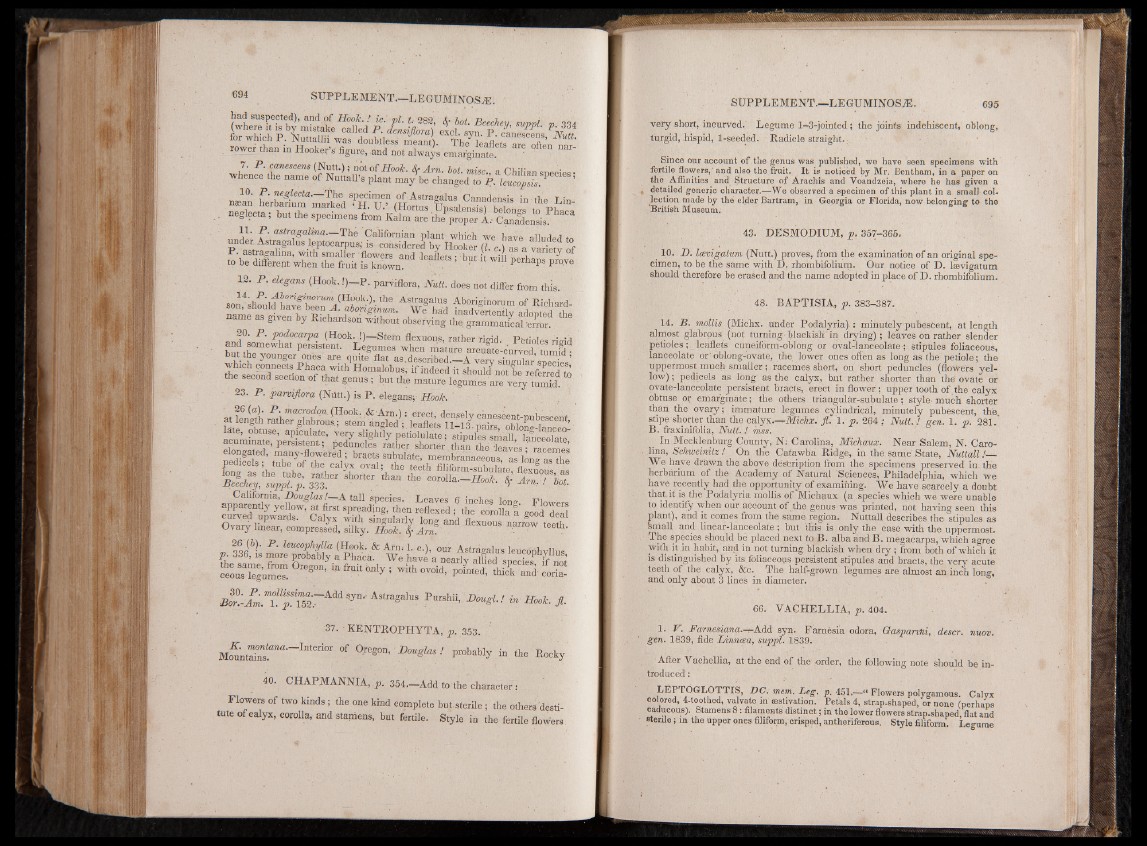
*°V v ' ™gJ‘ecta— ‘The specimen of Astragalus Canadensis in the T in
<mdto £ » S to w 5 * - S’SSed'by'HSS j?.'. >£ a “ 5 5 ZSS8SSZ «& JET1**J ‘ -*4 4 «S&
12. P . elegans (Hook.!)—P. parviflora, Nutt. does, not differ from this •^£±sxes^3S^MKKKMmi ame as given by Richardson without observing the grammatical' error.
Hnj°' P ' P°d°carPa (Hook. !)—Stem flexuous, rather rigid.- Petioles rieid
bn , “ r hat persistent- legum es when mature arcufte^-eurved, tumuL
but the younger ones are quite flat as.described.-A very singular spedes
which connects Phaca with Homalobus; if indeed it shoulffnot be referred to
the second section of that genus ; but the mature t0
23. P . parviflora (Nutt.) is P :. elegans;. Hook. '
fate611^ Tather stem hngledV.
p e d if e k ’ ; braCt1 su^ula^> membranaceous, as long as the
C T n l , n f * \ ly? °Val; the teeth filiform-subulate, flexuous as
3 3 ? “ “er- .* g f e | *ot.
California, Douglas!—A tall species. Leaves 6 inchps lnno- ru„
apparently yellow, at first spreading, then r e ified - the com HI curved upwards. Calyx 4 h tring.fi
Ovary linear, compressed, silky. Hook. $ A m / ™ " W teeth‘
26 (6). P . leucophyll'a (Hook, & Arm 1. c.l our K ifmidRt i„„„ C
R. 336, is more probably i Phaca- We
° " 80" ' ,B “ • « * • * * f c f * » i s
* * ,y ” ' * * * * * VcntgU in-Host. f .
37. • KENTROPHYTA, p. 353. *
M ( L S araffl'_ In te ri°r °f °*reg°n’ DouS las | Probably in the Rocky
40. CHAPMANNIA, p. 354,-Add to the character s
Flowers of two kinds ; the one kind complete but sterile ; the others destitute
of calyx, corolla, and stamens, but fertile. Style in the fertile flowers
very short, incurved. Legume 1—3-joinled; the joints indehiscent, oblong,
turgid, hispid, 1-seeded. Radicle straight. ;
Since our account of the genus was published, we have seen specimens with
fertile flowers,' and also the fruit. It is noticed by Mr. Bentham, in a paper on
the Affinities and Structure of Aracbis and Voandzeia, where he has given a
detailed generic character.—We observed a specimen of this plant in a small collection
made by the elder Bartram, in Georgia or Florida, now belonging to the
British Museum.
43. DESMODIUM, p. 357-365.
!_ 10. D. leevigatum (Nutt.) proves, from the examination of an original specimen,
to be the same with D, rhombifoliurn. Our notice of D. laevigatum
should therefore be erased and the name adopted in place of D. rhombifolium.
48. BAPTISIA, p. 383-387.
14. B. mollis (Michx. under Podalyria).: minutely pubescent, at length
almost glabrous (not turning blackish in drying) ; -leaves on rather slender
petioles; leaflet's cuneiform-oblong or oval-lanceolate-; stipules foliaceous,
lanceolate or oblong-ovate, the lower ones often as long as the petiole; the
uppermost much smaller ; racemes short, on short peduncles (flowers yellow);
pedicels as long as the calyx, b.ut rather shorter than the'ovate or
ovate-lanceolate persistent bracts, erect in flower; upper tooth of the calyx
obtuse or emarginate; the others triangular-subulate; style-much shorter
than the ovary; immature legumes cylindrical, minutely pubescent, the
stipe shorter than the calyx.—Michx. fl. 1. p. 204 ; Nutt.J gen. L. p. 281.'
B. fraxinifoiia, Nutt. ! mss.
. In Mecklenburg County, N: Carolina, Michaux. Near Salem, N. Carolina,
Schweinitz ! On the Catawba Ridge, in the same State, Nuttall!__
We have drawn the above description from the specimens preserved in. the
herbarium of the Academy of Natural Sciences, Philadelphia, which we
have, recently had the opportunity of examining. We have scarcely a doubt
that.it is the Podalyria mollis of Michaux (a species which we were unable
to identify when Our account of the. genus was printed, not having seen this
plant), and it comes from the same region. Nuttall describes the stipules as
small and linear-lanceolate; but this is only the case with the uppermost.
The Species should be placed next to B. alba and B. mbgacarpa, which agree
with it in habit, an,d in not turning blackish when dry ; from both of which it
is distinguished by its foliaceous persistent stipules and bracts, the very' acute
teeth of the calyx, &c. The half-grown legumes are almost an inch long,
and only about 3 lines in diameter. - ‘ , t . v
66. VAGHELLIA, p. 404.
1. V . Farnesia.na.-i-Add syn. Famesia odora, Gaspantii, descr. nuov.
gen. 1839, fide Linntsa, suppl. 1839.
. After Vachellia, at the end of the -order, the following note should be introduced
:
LEP rOGLOTTIS, DC. mem. Leg. p. 451.—“ Flowers polygamous. Calyx
colored, 4-toothed, valvate in «estivation. Petals 4, strap-shaped, or none (perhaps
caducous). Stamens 8 : filaments distinct; in the lower flowers strap-shaped flat and
sterile; in the upper ones filiform, crisped, antheriferous. Style filiform. Legume